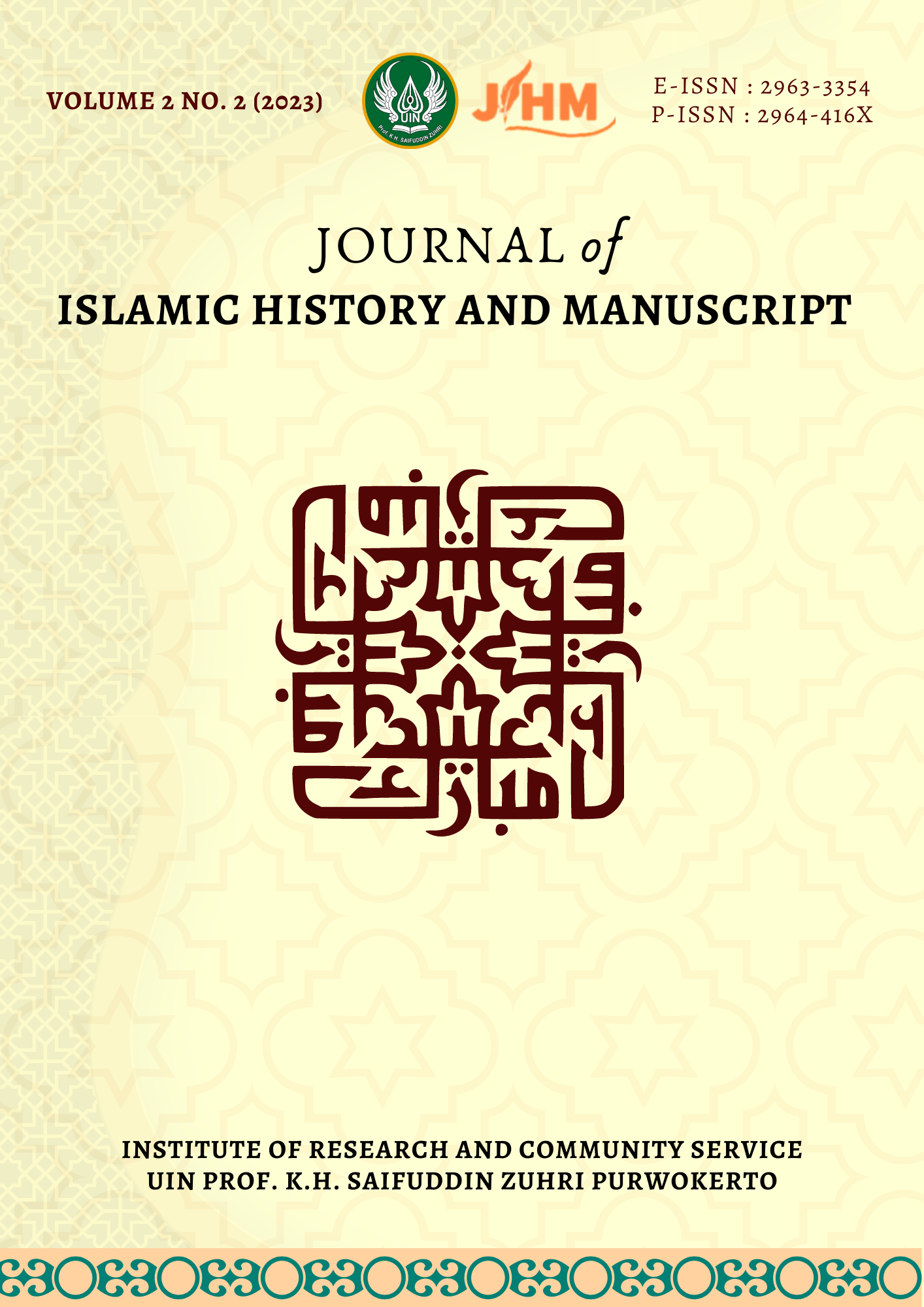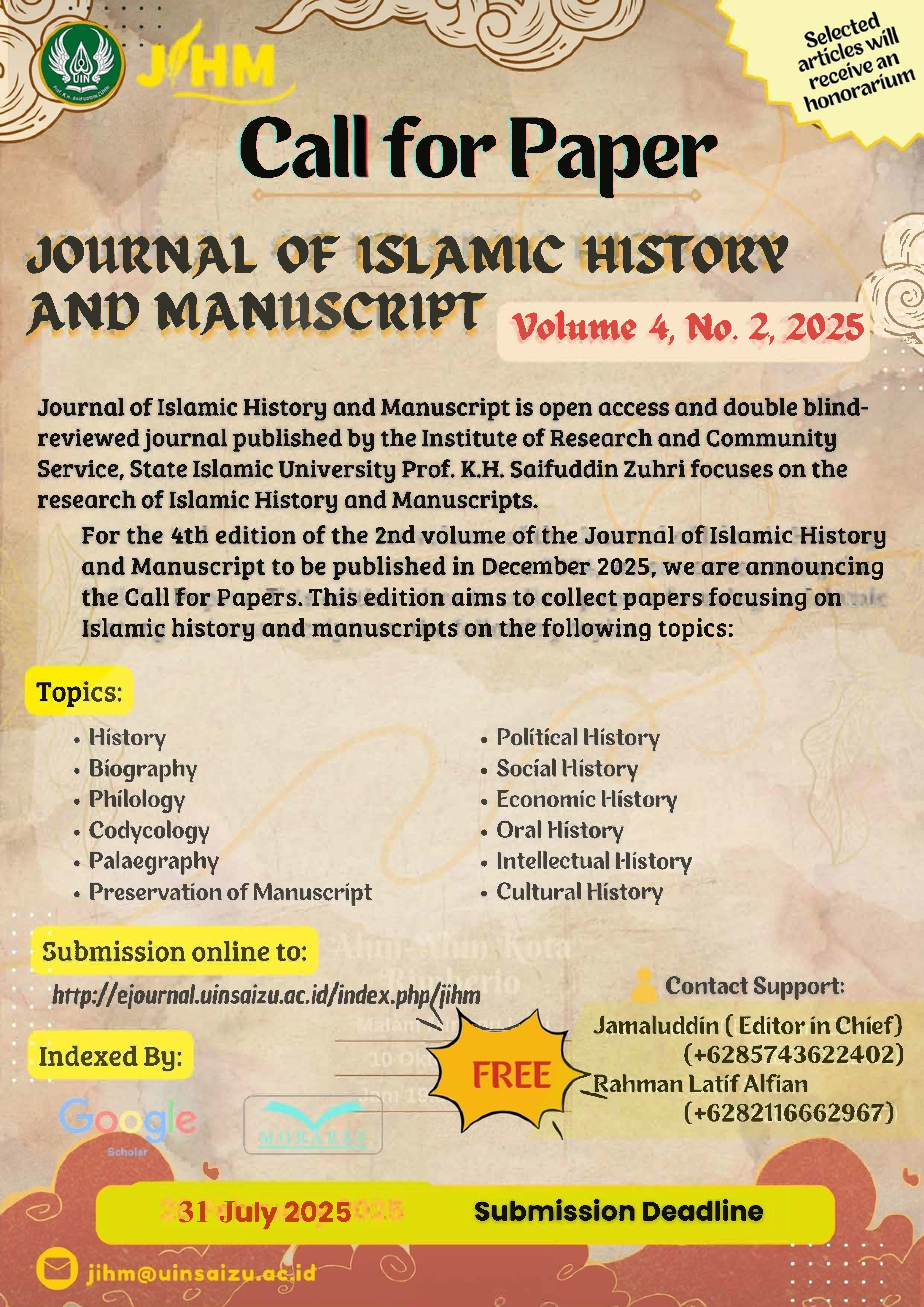History of Maqtal al-Hossein Documents: From Factual History to Fictional History
DOI:
https://doi.org/10.24090/jihm.v2i2.7864Kata Kunci:
Maqtal al-Hossein, Ashura, KarbalaAbstrak
The chronological account of Maqtal al-Hossein is a literary work that has been preserved and has become a source of inspiration for the formation of the collective identity of the Shi'a. However, Maqtal al-Hossein as a literary work, written based on the subjective understanding of its author, also leaves traces of distortion in the writing of Maqtal al-Hossein itself. This article aims to illustrate the gradual shift of Maqtal al-Hossein's narrative from historical to fictional. This article discusses (1) A discussion of the history of the writing of Maqtal al-Hossein as a development of literacy by previous writers, followed by a review of the history of the writing of the historical kitab Maqtal al-Hossein from the second century to the writing of Maqtal al-Hossein in the tenth century Hijri. (2). A review of the critical analysis of the text of the hadiths of Maqtal al-Hossein that indicated fiction from the third century Hijri to the tenth century Hijri in the two kitabs of Maqtal al-Hossein in the third century and Maqtal al-Hossein in the seventh century Hijri. The conclusion of this article shows that the writing of Maqtal al-Hossein from the period of the third century Hijri to the tenth century Hijri provides an argument about the shift in the historical value of writing the history of Maqtal al-Hossein, from historical facts to fictional narratives. Meanwhile, the writing of Maqtal al-Hossein from the tenth century was also influenced by the various interests of Islamic power at that time.Referensi
al-Amin, H. (1987). Mustadrakat A’yan al-Syi’ah.
Dadashnezad, M., & Gudarzhi, E. (2016). Naqsh Zaman wa Makan wa Muqtaziat Anha dar Barrasi Guzaresh Hoye Ashura. Jurnal Of Shia Studies, 2(6). https://shia.urd.ac.ir/article_43152.html?lang=fa
Ja’fariyan, R. (2002). Dar Borehe Manabi’ Tharikh Ashura. Ayeneh Pazhuhesh, 12(12 (17)), 41–52.
Kadivar, M. (2020, Oktober). Az Kabala Tarikhi To Karbala Asathir. Mohsen Kadivar Official Website. https://kadivar.com/18241/
Najafabadi, N. S. (2004). Shahid Javid.
Ranjbar, M. (2007a). Siri dar Maqtal Newishi va Tarikh Negari Ashuro az Aghoz to Ashre Hozir (2). Jurnal Of Tarikh Dar Ayene Pezhuhezh, Imam Khomeini Educational and Research Institute, 4(3). https://www.noormags.ir/view/fa/articlepage/315603/text/
Ranjbar, M. (2008). Siri dar Maqtal Newishi va Tarikh Negari Ashuro az Aghoz to Ashre Hozir (3). Jurnal Of Tarikh Dar Ayene Pezhuhezh, Imam Khomeini Educational and Research Institute, 4(4). https://doi.org/, https://www.noormags.ir/view/en/articlepage/745969/
Ranjbar, M. (2007b). Siri dar Maqtal Newishi va Tarikh Negari Ashuro az Aghoz to Ashre Hozir (1). Tarikh Eslami Dar Oyeneh Pazhuhes, 14.
Ranjbar, M., & Muftakhiri, H. (2008). Ruye Karde Ehsosi—Athifi Bih Waqi’i Ashuro Dar Iran, (Az Shafavi To Mashruteh). A Quarterly For Shia Study. https://www.noormags.ir/view/fa/magazine/number/27457
Ref’at, Mohsen. (2021). Naqd va Barrasi Riwayat Anggareha Sayid bin Thawwus Dar Luhouf. A Quarterly For Shia Study, 19(3). https://www.shiitestudies.com/article_249552.html
Thaba’thaba’i, A. A. (1996). Ahl al-Bayt fi al-Maktabah al-Arabiyyah. Muassasah Alu Bayt li Ihya’ al-Turats.
Unduhan
Diterbitkan
Cara Mengutip
Terbitan
Bagian
Lisensi
Hak Cipta (c) 2023 Khoirunnisa Muhammad

Artikel ini berlisensi Creative Commons Attribution 4.0 International License.
Authors who publish in this journal agree to the following terms:
- Authors retain copyright and grant the journal right of first publication with the work simultaneously licensed under a Creative Commons Attribution 4.0 International License. that allows others to share the work with an acknowledgment of the work's authorship and initial publication in this journal.
- Authors can enter into separate, additional contractual arrangements for the non-exclusive distribution of the journal's published version of the work (e.g., post it to an institutional repository or publish it in a book), with an acknowledgment of its initial publication in this journal.
- Authors are permitted and encouraged to post their work online (e.g., in institutional repositories or on their website) before and during the submission process, as it can lead to productive exchanges and earlier and greater citation of published work (See The Effect of Open Access).

















